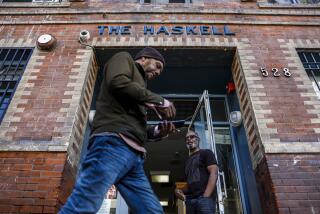Changes in store for hotel rooms, rates
AS we head further down the road in 2006, our heads throbbing from $400-per-night room tabs, we can look forward to a little rate relief, more luxuries and some snazzy new lodgings.
Budget lodgers will get more choices this year because limited-service hotels are opening at a red-hot rate. Pickings will be slimmer for jet-setters, but from Bali to Miami’s South Beach, they will find a few new places to empty their wallets. Often they will be sharing an address with millionaires who own residences next door.
Trend watchers, meanwhile, see better beds, bigger rooms, sybaritic baths and spas and high-tech gizmos.
But first, about those room prices. After falling, then stalling after the Sept. 11, 2001, terrorist attacks, which depressed the travel industry, the rates are bouncing back.
Room rates in major U.S. hotel markets last year increased an average of 7.5%, to $105 per night, according to PKF Consulting, an international firm of consultants and specialists in the hotel and tourism industries.
The main reason for the rise, experts say, is that supply and demand are out of sync. The pace of U.S. hotel openings, slowed by financial forces, bottomed out in 2004 and only recently began to pick up, said Patrick Ford, president of Lodging Econometrics, a research and consulting firm in Portsmouth, N.H., that tracks lodging construction trends.
Travel, meanwhile, has rebounded, creating more demand for beds.
For many reasons, including a surge in midpriced hotel openings, the increase in room rates will probably slow in 2006, said Robert Mandelbaum, Atlanta-based director of research information services for PKF.
But don’t expect much of a break in New York. Manhattan room rates shot up 16% in 2005 to a record $234 per night, preliminary data show, and they’re headed at least 12% higher this year, said John A. Fox, PKF’s senior vice president in New York. Booming business travel, costly real estate and sky-high construction costs will keep Manhattan rates up, Fox said.
You can also blame an industrywide trend of converting hotel rooms to luxury condos. Partly as a result, Manhattan has about 1,500 fewer hotel rooms now than it did two years ago, Fox said.
Boutique hotelier Ian Schrager, for instance, in May plans to reopen the landmark Gramercy Park Hotel, which once had several hundred rooms, as a mixed hotel-condo project.
Industrywide, experts say, about 85% of luxury hotel projects now include a residential component. Such additions help lenders recover construction costs more quickly and appeal to well-heeled buyers, who may enjoy housekeeping, concierge and other hotel services, many for free.
Among luxury hotel openings this year: a resort in the Maldives and a tented camp in Chiang Rai, Thailand, both by Four Seasons; Hyatt Regency hotels in Guangdong and Shanghai in China; InterContinentals in Baltimore and Boston (both with condos); a Ritz-Carlton in Moscow; a Bulgari — a joint venture with Ritz-Carlton — in Bali; and a St. Regis Resort on Bora-Bora in the South Pacific.
Among boutique-type openings will be Hard Rock hotels in New York and Madrid; Hotel Palomars in Dallas and Washington, D.C., plus the Ritz Plaza in South Beach, all by Kimpton; and Hotel Angeleno, an iconic, circular Holiday Inn in Brentwood being remade by Joie de Vivre Hospitality. In San Diego, the landmark US Grant is slated to reopen as a Starwood hotel after a $52-million makeover.
But the real news — flying under the radar of such high-profile debuts — is the explosive growth in limited-service hotels, such as Hampton Inn, Holiday Inn Express and Choice Hotels.
These lodgings, which offer reasonable comfort at moderate prices, will be the industry’s fastest-growing segment in 2006, said analyst Ford.
In suburbs, along the highway or on downtown fringes, they usually lack full food service but provide free breakfast, fitness facilities and other perks. They draw lots of business people, but their prices and predictability also appeal to vacationers.
Among such hotels opening in New York this year, for instance, are a Hampton Inn in the financial district and a Holiday Inn Express in Brooklyn.
*
Guest priorities
AS for service and amenities, “bed, bath and beyond” could be the mantra of the lodging industry this year, with “beyond” denoting technology, said analyst Peter Yesawich, chairman and chief executive of Yesawich, Pepperdine, Brown & Russell, a Florida-based marketing firm.When asked how they choose where to stay, 59% of American leisure travelers say premium-quality bedding and linen are very important, Yesawich said, based on annual surveys that his company cosponsors.
The resulting “thread-count wars” among hotels are good news for consumers, he said, as are trends toward bigger guest rooms and baths, with fancy soaps and other amenities.
During the last two years, for instance, Hilton hotels have deployed the Hilton Serenity Collection — their bedding contender, with Serta Suite Dreams mattresses and Pacific Coast down pillows — and added Crabtree & Evelyn La Source toiletries to baths.
In technology, Yesawich said, the 2006 watch phrase for hoteliers is: “Expect to be fired if you’re not wired.”
Guests, especially business people, he said, are demanding high-speed and wireless Internet access, and they don’t want to pay for it.
Typically, tapping the Internet is free at limited-service hotels but not at full-service ones.
At Hiltons, for instance, the usual tab is $9.95 for 24 hours of high-speed Internet access in guest rooms, said Jeffrey Diskin, Hilton brand manager. But at Hampton Inns, a limited-service sister brand of Hilton, there is no charge, said spokeswoman Bonnie Cameron.
Will 2006 be the year the Net breaks free at hotels?
Stay tuned.
*
For a list of lodgings with phones and websites, go to latimes.com/lodgings.
More to Read
Sign up for The Wild
We’ll help you find the best places to hike, bike and run, as well as the perfect silent spots for meditation and yoga.
You may occasionally receive promotional content from the Los Angeles Times.






